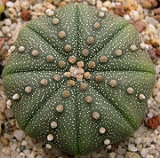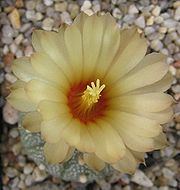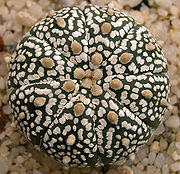
Astrophytum asterias
Encyclopedia
Astrophytum asterias is a species of cactus
in the genus Astrophytum
, and is native to small parts of Texas
in the United States
and Mexico
. Common names include Sand Dollar Cactus, Sea Urchin Cactus, Star Cactus and Star Peyote.
 A. asterias is small, round, spineless and squat, reaching a height of 2.5–6 cm (0.984251968503937–2.4 in) and a diameter of 5–15 cm (2–5.9 in). The disc-shaped body is divided into 7 - 10 sections, known as ribs; in the middle of each rib there are woolly areoles. The body is a greenish-brown colour and may appear speckled from its covering of white scales. The flowers of this cactus are yellow with red bases and the outer parts are very woolly. Green to pink oval fruits are produced; the outside coat is covered with woolly hairs.
A. asterias is small, round, spineless and squat, reaching a height of 2.5–6 cm (0.984251968503937–2.4 in) and a diameter of 5–15 cm (2–5.9 in). The disc-shaped body is divided into 7 - 10 sections, known as ribs; in the middle of each rib there are woolly areoles. The body is a greenish-brown colour and may appear speckled from its covering of white scales. The flowers of this cactus are yellow with red bases and the outer parts are very woolly. Green to pink oval fruits are produced; the outside coat is covered with woolly hairs.
of Texas
in the United States
and the states of Nuevo León
and Tamaulipas
in Mexico
, to the east of the Sierra Madre Oriental mountain range.
Previously more abundant, this species is today restricted to a single 200-acre site in Texas, where there are around 2,000 individuals, and a few small sites in Tamaulipas. Today this species is associated with thorn scrub, amongst rocky ground; it may have previously occupied richer, flat grasslands that have since been developed. It has probably been extirpated
from Nuevo León
.
, since the 1840s, like other members of its genus and despite its rarity in the wild. It is readily propagated from seed, so most plants encountered in nurseries are seed grown. The popularity of this species among collectors and enthusiasts has ensured that a number of cultivar
s are available. One such cultivar is the 'Super Kabuto', a highly spotted white clone.

by the United States Fish and Wildlife Service
, vulnerable
on the International Union for Conservation of Nature's Red List
, and critically imperiled by The Nature Conservancy
. listed on Appendix I of the Convention on International Trade in Endangered Species of Wild Fauna and Flora (CITES), meaning that international trade in wild-collected specimens is prohibited. Despite this protection, illegal collection continues to threaten the future of this species. and its decline in the wild has been largely attributed to over-collection and poaching. It is sometimes accidentally harvested due to its similarity to the closely related and coexisting Peyote
(Lophophora williamsii). Other contributing factors are thought to be urban development and herbicides. Habitat destruction has been, and remains, the major cause of the decline in this species; vast areas have been converted to agricultural
use and road construction. In Texas, mechanical and chemical bush clearing techniques together with the introduction of invasive grasses have had devastating effects.
The U.S. Fish & Wildlife Service have drafted a Recovery Plan in an attempt to secure the future of this species. The Recovery Plan highlights the need to protect existing populations, carry out research into possible new populations and to develop a formal conservation agreement between the United States and Mexico.
Cactus
A cactus is a member of the plant family Cactaceae. Their distinctive appearance is a result of adaptations to conserve water in dry and/or hot environments. In most species, the stem has evolved to become photosynthetic and succulent, while the leaves have evolved into spines...
in the genus Astrophytum
Astrophytum
Astrophytum is a genus of six species of cacti. These species are sometimes referred to as living rocks, though the term is also used for other genera, particularly Lithops . The generic name is derived from the Greek words άστρον , meaning "star," and φυτόν , meaning "plant."-Species:* Astrophytum...
, and is native to small parts of Texas
Texas
Texas is the second largest U.S. state by both area and population, and the largest state by area in the contiguous United States.The name, based on the Caddo word "Tejas" meaning "friends" or "allies", was applied by the Spanish to the Caddo themselves and to the region of their settlement in...
in the United States
United States
The United States of America is a federal constitutional republic comprising fifty states and a federal district...
and Mexico
Mexico
The United Mexican States , commonly known as Mexico , is a federal constitutional republic in North America. It is bordered on the north by the United States; on the south and west by the Pacific Ocean; on the southeast by Guatemala, Belize, and the Caribbean Sea; and on the east by the Gulf of...
. Common names include Sand Dollar Cactus, Sea Urchin Cactus, Star Cactus and Star Peyote.
Description

Biology
Reproduction takes place via sexual outcrossing through cross-pollination; star cacti reach sexual maturity after a few years, when they have attained 2 – 3 cm in diameter. Flowers are produced from March to June (the summer season in its native habitat) and fruiting occurs from April to June; the specific pollinators have not been identified but are thought to be insects.Distribution and habitat
Star cactus is native to the lower Rio Grande ValleyRio Grande Valley
The Rio Grande Valley or the Lower Rio Grande Valley, informally called The Valley, is an area located in the southernmost tip of South Texas...
of Texas
Texas
Texas is the second largest U.S. state by both area and population, and the largest state by area in the contiguous United States.The name, based on the Caddo word "Tejas" meaning "friends" or "allies", was applied by the Spanish to the Caddo themselves and to the region of their settlement in...
in the United States
United States
The United States of America is a federal constitutional republic comprising fifty states and a federal district...
and the states of Nuevo León
Nuevo León
Nuevo León It is located in Northeastern Mexico. It is bordered by the states of Tamaulipas to the north and east, San Luis Potosí to the south, and Coahuila to the west. To the north, Nuevo León has a 15 kilometer stretch of the U.S.-Mexico border adjacent to the U.S...
and Tamaulipas
Tamaulipas
Tamaulipas officially Estado Libre y Soberano de Tamaulipas is one of the 31 states which, with the Federal District, comprise the 32 Federal Entities of Mexico. It is divided in 43 municipalities and its capital city is Ciudad Victoria. The capital city was named after Guadalupe Victoria, the...
in Mexico
Mexico
The United Mexican States , commonly known as Mexico , is a federal constitutional republic in North America. It is bordered on the north by the United States; on the south and west by the Pacific Ocean; on the southeast by Guatemala, Belize, and the Caribbean Sea; and on the east by the Gulf of...
, to the east of the Sierra Madre Oriental mountain range.
Previously more abundant, this species is today restricted to a single 200-acre site in Texas, where there are around 2,000 individuals, and a few small sites in Tamaulipas. Today this species is associated with thorn scrub, amongst rocky ground; it may have previously occupied richer, flat grasslands that have since been developed. It has probably been extirpated
Local extinction
Local extinction, also known as extirpation, is the condition of a species which ceases to exist in the chosen geographic area of study, though it still exists elsewhere...
from Nuevo León
Nuevo León
Nuevo León It is located in Northeastern Mexico. It is bordered by the states of Tamaulipas to the north and east, San Luis Potosí to the south, and Coahuila to the west. To the north, Nuevo León has a 15 kilometer stretch of the U.S.-Mexico border adjacent to the U.S...
.
Cultivation
Sand Dollar Cactus has been grown as a houseplantHouseplant
A houseplant is a plant that is grown indoors in places such as residences and offices. Houseplants are commonly grown for decorative purposes, positive psychological effects, or health reasons such as indoor air purification...
, since the 1840s, like other members of its genus and despite its rarity in the wild. It is readily propagated from seed, so most plants encountered in nurseries are seed grown. The popularity of this species among collectors and enthusiasts has ensured that a number of cultivar
Cultivar
A cultivar'Cultivar has two meanings as explained under Formal definition. When used in reference to a taxon, the word does not apply to an individual plant but to all those plants sharing the unique characteristics that define the cultivar. is a plant or group of plants selected for desirable...
s are available. One such cultivar is the 'Super Kabuto', a highly spotted white clone.

Conservation
As with certain other slowly maturing cacti, A. asterias is listed as endangeredEndangered Species Act
The Endangered Species Act of 1973 is one of the dozens of United States environmental laws passed in the 1970s. Signed into law by President Richard Nixon on December 28, 1973, it was designed to protect critically imperiled species from extinction as a "consequence of economic growth and...
by the United States Fish and Wildlife Service
United States Fish and Wildlife Service
The United States Fish and Wildlife Service is a federal government agency within the United States Department of the Interior dedicated to the management of fish, wildlife, and natural habitats...
, vulnerable
Vulnerable species
On 30 January 2010, the IUCN Red List of Threatened Species identified 9694 Vulnerable species, subspecies and varieties, stocks and sub-populations.-References:...
on the International Union for Conservation of Nature's Red List
IUCN Red List
The IUCN Red List of Threatened Species , founded in 1963, is the world's most comprehensive inventory of the global conservation status of biological species. The International Union for Conservation of Nature is the world's main authority on the conservation status of species...
, and critically imperiled by The Nature Conservancy
The Nature Conservancy
The Nature Conservancy is a US charitable environmental organization that works to preserve the plants, animals, and natural communities that represent the diversity of life on Earth by protecting the lands and waters they need to survive....
. listed on Appendix I of the Convention on International Trade in Endangered Species of Wild Fauna and Flora (CITES), meaning that international trade in wild-collected specimens is prohibited. Despite this protection, illegal collection continues to threaten the future of this species. and its decline in the wild has been largely attributed to over-collection and poaching. It is sometimes accidentally harvested due to its similarity to the closely related and coexisting Peyote
Peyote
Lophophora williamsii , better known by its common name Peyote , is a small, spineless cactus with psychoactive alkaloids, particularly mescaline.It is native to southwestern Texas and Mexico...
(Lophophora williamsii). Other contributing factors are thought to be urban development and herbicides. Habitat destruction has been, and remains, the major cause of the decline in this species; vast areas have been converted to agricultural
Agriculture
Agriculture is the cultivation of animals, plants, fungi and other life forms for food, fiber, and other products used to sustain life. Agriculture was the key implement in the rise of sedentary human civilization, whereby farming of domesticated species created food surpluses that nurtured the...
use and road construction. In Texas, mechanical and chemical bush clearing techniques together with the introduction of invasive grasses have had devastating effects.
The U.S. Fish & Wildlife Service have drafted a Recovery Plan in an attempt to secure the future of this species. The Recovery Plan highlights the need to protect existing populations, carry out research into possible new populations and to develop a formal conservation agreement between the United States and Mexico.

